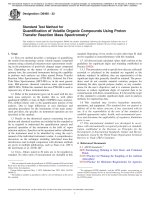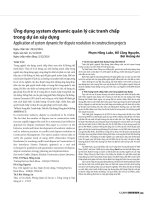Computational design of zno based catalysts for chemical systems
Bạn đang xem bản rút gọn của tài liệu. Xem và tải ngay bản đầy đủ của tài liệu tại đây (785.57 KB, 39 trang )
National Taiwan University of
Science and Technology
Department of Chemical Engineering
PhD Thesis
ID: D9706815
Computational Design of ZnO-Based
Catalysts for Chemical Systems
Author: Vo Thanh Cong
Advisor: Professor Jyh-Chiang Jiang
Spring Semester
July 2013
G
N
O
C
H
N
A
H
T
O
V
s
t
s
y
l
a
t
a
C
d
e
s
a
B
Os
nm
Ze
fs
t
o
y
nS
gl
i
a
s
c
e
i
Dm
le
a
h
nC
or
i
t
o
a
f
t
u
p
m
o
C
博士論文
國立台灣科技大學
化 學 工 程 系
101
Acknowledgments
I have benefited from numerous people and many facilities during my
graduate study at the National Taiwan University of Science and Technology. First, I
would like to acknowledge my advisor, Professor Jyh-Chiang Jiang, whose
enthusiasm and expertise were greatly appreciated.
I am very grateful for many current and former members of my lab (T2-513)
for their support. Of special note are Dr. Wang, Dr. Ni, and Mr. Hung. I spent a
wonderful student life in the University of Science and Technology-Taiwan with
numerous friends. They supported lots information for me to understand the good
living at school. At last, I would like to thank my loving parents, beautiful wife, for
their endless support. This work has been supported by the National Science Council,
Taiwan (NSC 99-2113-M-011-001-MY3) and the National Center of HighPerformance Computing (NCHC) for computer time and facilities.
1
Abstract
As a semiconductor with a hexagonal wurtzite crystal structure and wide direct band gap,
zinc oxide (ZnO) has a wide range of technological uses. It is widely known that, in combination
with other metal particles (e.g., Na, Cu, Pd and Ti) at the surface, ZnO, in general, has better
selectivity and catalytic performance. Thus, in this study we investigate the pure ZnO and
modification of ZnO (1010) surface by doping and depositing different types of metals in attempt to
design better catalysts for several important chemical reactions including; (1) methanol
decomposition on ZnO surface; (2) CO oxidation on undoped and Ti doped ZnO surface; and (3)
the water gas-shift reaction (WGS) on 2Cu deposited ZnO surface. To detail, the adsorption and
reaction mechanisms of methanol decomposition, CO oxidation, and water gas shift on pure and
modified ZnO(1010) surfaces have been investigated using density functional theory (DFT) slab
calculations, respectively. In addition, the effect of the adsorption bonding between adsorbates and
surfaces are studied also using density of states (DOS) and electron density difference (EDD)
contour plots. The understanding on these systems will help to shed more light on how to design
better catalytic materials for different chemical systems.
Keywords: Density Functional Theory (DFT); ZnO 1010 ; CO Oxidation, Methanol
decomposition, Water Gas-Shift Reaction.
2
TableofContents
Abstract .......................................................................................................................... 2
Chapter 1: Introduction ................................................................................................ 15
1.1. Fuel cell ......................................................................................................... 15
1.1.1.
Background ............................................................................................ 15
1.1.2.
Fuel cell principle and fuel cell types .................................................... 16
1.1.3.
The hydrogen generation via methanol.................................................. 19
1.1.4.
CO oxidation .......................................................................................... 21
1.1.5.
Water gas shift reaction (WGSR) .......................................................... 22
1.2. Catalytic performances .................................................................................. 23
1.2.1.
Catalyst development ............................................................................. 23
1.2.2.
Bravais-miller index - case of ZnO structures ....................................... 25
1.3. This research ................................................................................................. 26
Chapter 2: Computational Details ................................................................................ 28
2.1. Theoretical background ................................................................................. 28
3
2.2. Method and parameters in this work ............................................................. 34
Chapter 3: Surface Models........................................................................................... 37
3.1. ZnO (1010) surface. ...................................................................................... 37
3.2. Ti doped ZnO (1010) surface ......................................................................... 41
3.3. Two Cu atoms deposited on ZnO (1010) surface .......................................... 44
Chapter 4: Methanol Decomposition on ZnO (1010) Surface .................................... 49
4.1. Methanol adsorption ...................................................................................... 49
4.2. Electron density difference analysis .............................................................. 51
4.3. CH3OH decomposition on ZnO (1010) surface ............................................ 53
4.4. Conclusions ................................................................................................... 59
Chapter 5: CO Oxidation on Undoped and Ti Doped on ZnO (1010) Surface ........... 61
5.1. CO adsorption on undoped ZnO surface. ...................................................... 61
5.2. CO adsorption on Ti doped ZnO surface. ..................................................... 68
5.3. Reaction mechanisms .................................................................................... 70
4
5.3.1.
Undoped ZnO (1010) surface .................................................................. 71
5.3.2.
Ti doped ZnO (1010) surface .................................................................. 74
5.3.3.
Restored surface ..................................................................................... 75
5.4. Conclusions ................................................................................................... 77
Chapter 6: Water Gas Shift Reaction on 2Cu Deposited ZnO (1010) Surface ........... 78
6.1. Adsorption of reactants, intermediates, and products on the 2Cu/ZnO (1010)
surface ...................................................................................................................... 79
6.2. Conversion of CO and H2O on the 2Cu/ZnO (1010) surface ......................... 85
6.3. Desorption products ...................................................................................... 95
6.4. Conclusions ................................................................................................... 98
5
Index of Figures
Figure 1. Chart to summarize the applications and main advantages of fuel cells of
different types, and in different applications. ---------------------------------------------- 17
Figure 2. Wurtzite structure of ZnO. -------------------------------------------------------- 26
Figure 3. The ZnO (1010) surface model: two-dimensional view with 15Å vacuum
slab and six layers representation where the first two upper and the four bottom layers
in the (1010) direction. The blue and red balls are Zn and O atoms, respectively. --- 35
Figure 4. A side view of relaxation and reconstruction on ZnO (1010) surface. In
which Figure 4(a) shows six layer structure; Figure 4(b) is an extraction (bordering by
the dashed circle) from Figure 4(a) to describe the relaxed surface. Compared to its
bulk structure, the surface Zn-O bond tilts, marked with parameter θ and the bond
linked between the surface zinc and oxygen contracts shown by d. -------------------- 38
Figure 5. The side-view of the (2x2)-ZnOsupercell of Ti-doped systems. Only first
two outermost layers in the direction (1 010 ) are shown. More detailed description
about the tilt angle (α) can be found in the work of Wander. ---------------------------- 43
Figure 6. Local density of state (LDOS) analysis for the surface oxygen bonded to the
undoped ZnO surface (grey line) and Ti doped ZnO surface (black line). ------------ 44
6
Figure 7. The most stable site (site E from Table S2, see in appendix) was chosen for
calculations in WGSR. In which, (a), (b) noted a top view and site view of structural
site E. The black circle of in each (a) and (b) noted that different positions of Cu-site
and IF-site on 2Cu/ZnO (1 010 ) surface. ------------------------------------------------- 46
Figure 8. The electronic properties of 2Cu atoms adsorbed on ZnO (1 010 ) surface.
Figure 8(a) shows DOS analysis of 2Cu adsorption on the surface in which the top
box is states of 2Cu atoms before (grey line) and after adsorption (dash line), and the
bottom box notes the states of ZnO before (grey line) and after (dash line) adsorption;
Figure 8(b) presents EDD contour plot of 2Cu adsorption on the surface, where the
dash-line is represented Cu electrons loss, and solid line as electrons accumulation of
adsorbate-surface. ----------------------------------------------------------------------------- 48
Figure 9. Configuration of CH3OH adsorbed on ZnO (1010) surface at three different
adsorption sites. All bond distances (black-arrow line) are in Å. Shaded white spheres
represent the hydrogen, the grey ones are the carbon atoms. ---------------------------- 49
Figure 10. Electron density difference contour plot of CH3OH adsorbed on ZnO
(1010) surface at (a) site A, (b) site B, and (c) site (C) models. In which, the dashlines represents the loss of electron and the solid-lines show electron accumulation. 52
7
Figure 11. In each box, the top and bottom shown transition and final states structures
of CH3OH decomposition on ZnO (1010) surface; (a), (b), and (c) present O-H, C-H,
and C-O bond breaking of site A, respectively, (d), (e) as O-H-C, and C-O bond
breaking of site C. ----------------------------------------------------------------------------- 55
Figure 12. Calculated activation barrier and reaction energies (in eV) characterizing
C-O, C-H, and O-H bond breaking of MeOH on ZnO (1010) substrates with respect to
the energy calculated for the corresponding MeOH adsorption. ------------------------ 56
Figure 13. Reaction pathway of CH3OH decomposition of site A on clean ZnO (1010)
surface. ------------------------------------------------------------------------------------------ 57
Figure 14.The most stable structures of CO adsorption on the undopedZnO (1010)
surface (top) and the Ti-doped (1010) surface (bottom). --------------------------------- 62
Figure 15. The other less stable structures of CO adsorbed on the undoped ZnO (1010)
surface. ------------------------------------------------------------------------------------------ 63
Figure 16. Local density of state (LDOS) analysis of CO adsorption bounded to
surface. (a) LDOS projected on a CO molecule in gas phase; (b), (c) LDOS projected
CO adsorption on undoped ZnO and Ti doped ZnO surface, respectively. ----------- 64
8
Figure 17.The analysis of partial density of state (PDOS) of s and p orbitals of CO
before adsorption (clean) and after adsorbed on undoped and Ti doped ZnO surfaces
(bonded), respectively. ------------------------------------------------------------------------ 65
Figure 18. The analysis of partial density of state (PDOS) of dz2, dyz, and dxz orbitals
of CO before adsorption (clean) and after adsorbed on undoped and Ti doped ZnO
surfaces (bonded), respectively. ------------------------------------------------------------- 66
Figure 19. Electron density difference (EDD) contour plots analysis of CO molecule
binding to undoped and Ti-doped ZnO (1010) surface are shown in (a) and (b),
respectively.The solid and dashed lines represent increasing and decreasing electron
densities, respectively ------------------------------------------------------------------------- 67
Figure 20. The other less stable structures of CO adsorbed on the Ti doped ZnO
(1010) surface. --------------------------------------------------------------------------------- 68
Figure 21. Reaction pathway of CO oxidation on undoped (solid black lines) and Tidoped ZnO 1010 surface (solid grey line). In each box, the black box presents
structures of CO oxidation at every state on undoped surface, whereas the grey box is
structures of CO oxidation on Ti doped ZnO surface. ------------------------------------ 72
Figure 22. The structures and reaction energies to restored surfaces via O2 gas phase
and activated CO then to CO2 formation on undoped and Ti doped surfaces; the box
9
black line and grey line shows the structures to restored defects on undoped ZnO
(1010) and Ti doped ZnO surfaces, respectively. ----------------------------------------- 76
Figure 23. The most stable adsorption configurations for possible species involved in
the WGS at the Cu-site and IF-site of 2Cu/ZnO surface. In each panel from (a) to (j),
the upper panel shown side view of adsorption species at Cu-site, while lower panel
as side view of adsorption species at IF-site. ---------------------------------------------- 81
Figure 24. From Figure 24(a) to Figure 24(j) are shown as DOS analysis of
adsorbates, intermediates, and products adsorbed at IF-site and Cu-site on 2Cu/ZnO
surface, in which corresponding to configurations adsorption in Figure 23(a-j),
respectively. The black dash lines and solid lines shown positions of molecule bonded
to surface at Cu-site and IF-site, respectively; the grey solid line represent positions of
molecule in the gas phase. The black circles point out the interaction section between
molecules and surface. ------------------------------------------------------------------------ 84
Figure 25. Reaction pathway profile of H atom abstracted from H2O on 2Cu/ZnO
(1 010 ) surface at Cu-site (red-line) and IF-site (black-line). In each box, the box
with solid colored-red and dash colored-black show structural side view of initial,
transition, and final state at Cu-site and IF-site, respectively. --------------------------- 87
10
Figure 26. Reaction pathway of O-H bond is breaking at Cu-site on 2Cu/ZnO (1010)
surface. ------------------------------------------------------------------------------------------ 88
Figure 27. Reaction pathway of OH recombined at IF-site on 2Cu/ZnO (1010) surface.
--------------------------------------------------------------------------------------------------- 89
Figure 28. Reaction pathway profile of CO is oxidized by atomic O (Figure 28 (a))
and OH group (Figure 28 (b)) on 2Cu/ZnO (1 010 ) at Cu-site (red-line) and IF-site
(black-line), respectively.--------------------------------------------------------------------- 90
Figure 29. Reaction pathway profile of COOH dissociated (Figure 29(a)) and COOH
dissociation (Figure 29(b)) by OH group on 2Cu/ZnO (1 010 ) at Cu-site (red-line)
and IF-site (black-line), respectively. ------------------------------------------------------- 93
Figure 30. Reaction pathway profile of H2 recombined on 2Cu/ZnO (1 010 ) at Cusite (red-line) and IF-site (black-line), respectively. -------------------------------------- 94
Figure 31. Reaction pathway of CO2 desorption at Cu-site on 2Cu/ZnO (1010) surface
--------------------------------------------------------------------------------------------------- 95
Figure 32. Reaction pathway of H2 desorption at Cu-site on 2Cu/ZnO (1010) surface
--------------------------------------------------------------------------------------------------- 96
Figure 33. The graph of reaction network for WGSR, including both redox
mechanism and carboxyl mechanism at Cu-site and IF-site are listed. All of barrier
11
and reaction energy values are given in electronvolts (eV). The dash-arrow lines point
out reaction pathway is impossible. The solid-arrows and block-arrows are presented
different pathways of redox mechanism and carboxyl mechanism, respectively. ---- 97
12
Index of Tables
Table 1. Data for different types of fuel cell. ............................................................... 18
Table 2. Relaxation of the ZnO (1010) surface ........................................................... 39
Table 3. Binding energies, Eb (in eV) of CH3OH on ZnO (1010) surface with the
changes of cutoff energy (in eV), and k-points settings. ............................................. 41
Table 4. The average adsorption energy per adsorbate (
(
), and surface energy
) of 2Cu atoms adsorbed on ZnO (1010) surface. .................................... 45
Table 5. The bond length (R, in Å), bond distance (d, in Å), bond angle (ے, in
degree), and adsorption energies (Eads, in eV) for CH3OH adsorption on ZnO
(1010) surface with different adsorption sites. ............................................................. 50
Table 6.The calculated bond distances (d), bond angle and binding/adsorption
energies (Eads) for CO adsorption on undoped and Ti-doped ZnO (1010) surfaces (see
Figure 14 for the specific sites). ................................................................................... 62
Table 7. The important parameters and structures of initial (SP), transition (TS),
intermediate (IM), and final (FP) states for CO + Os→CO2. In which, Os is noted as
Oxygen neighboring atom of ZnO surface; the subscripts A and B represent path of
CO oxidation on undoped and Ti doped ZnO surfaces, respectively. ......................... 73
Table 8. Carboxyl mechanism vs redox mechanism for WGSR on 2Cu/ZnOa ........... 78
13
Table 9. Adsorption sites, selected adsorbate (A)-surface (S), bond distance (dA-S, in
Å), and adsorption energy Ead (in eV) for possible species involved in the WGSR at
Cu-site and IF-site on 2Cu/ZnO surface. ..................................................................... 80
Table 10. Result calculations of Ea, ∆H, and IMF for the elementary steps at Cu-site
and IF-site in WGSR. ................................................................................................... 86
14
Chapter 1: Introduction
1.1. Fuel cell
1.1.1.
Background
The principle of the fuel cell was discovered in 1838 by Christian Friedrich
Schonbein and published in one of the scientific magazines of the time. Based on this
work, the first fuel cell successfully converses chemical energy into electrical energy,
was demonstrated in 1839 by Sir William Grove1, a Welsh judge and gentleman
scientist. In however spite of the attractive system efficiencies and environmental
benefits associated with fuel-cell technology, it has been proved difficult to develop
the previous scientific experiments into commercially viable industrial products. The
history of these very early years have been described elsewhere.1, 2 Until the 1959s,
following Bacon’s pioneering work3, fuel cells were successfully developed for the
American manned space program. Fuel cells furnished power for the Gemini and
Apollo spacecraft, and still provide electricity and water for the space shuttle. This
success, together with a policy to commercialize space technology, led to substantial
development programs in America and Japan in the 1970s and the 1980s, and more
recently in Europe.4, 5
15
A fuel cell generates electrical power by continuously converting the chemical
energy of a fuel into electrical energy by way of an electrochemical reaction. A fuel
cell consists of an electrolyte and two electrodes. A fuel such as hydrogen is
continuously oxidized at the negative anode while an oxidant such as oxygen is
continuously reduced at the positive cathode. The electrochemical reactions take place
at the electrodes to produce a direct electric current. FCs use hydrogen as a fuel which
results in the formation of water vapor only and thus they provide clean energy. FCs
offer high conversion efficiency and hence is promising. The current status of fuel cell
technology for mobile and stationary applications has recently been discussed.6
1.1.2.
Fuel cell principle and fuel cell types
Leaving aside practical issues such as manufacturing and materials costs, the two
fundamental technical problems with fuel cells are
Theslowreactionrate,leadingtolowcurrentsandpower,discussed
briefly
Thathydrogenisnotareadilyavailablefuel.
To solve these problems, many different fuel cell types have been tried. The
different fuel cell types are usually distinguished by the electrolyte that is used,
16
though there are always other important differences as well. The situation now is that
six classes of fuel cell have emerged as viable systems for the present and near future.
Basic information about these systems is given in Table 1 and Figure 1.
Figure 1. Chart to summarize the applications and main advantages of fuel cells of
different types, and in different applications.5
17
Table 1. Data for different types of fuel cell.5
Fuel cell type
Mobile ion
Alkaline (AFC)
Proton
Operating
temperature
OH
50–200°C
H+
30–100°C
H+
20–90°C
H+
~220°C
CO32−
~650°C
O2−
500–1000°C
exchange
membrane
(PEMFC)
Direct methanol
(DMFC)
Phosphoric acid
(PAFC)
Molten carbonate
(MCFC)
Solid oxide
(SOFC)
Applications and notes
Used in space vehicles, e.g. Apollo, Shuttle.
Vehicles and mobile applications, and for lower power in
Combined Heat and Power (CHP) systems
Suitable for portable electronic systems of low power, running for
long times
Large numbers of 200-kW CHP systems in use.
Suitable for medium- to large-scale CHP systems, up to MW
capacity
Suitable for all sizes of CHP systems, 2kW to multi-MW.
18
The use of hydrocarbon or alcohol fuels requires an external fuel processor to be
incorporated into the system. This item not only increases the complexity and cost of the system,
but also decreases the overall efficiency. In contrast, molten-carbonate fuel cells (MCFCs) and
solid-oxide fuel cells (SOFCs) operating at higher temperatures have the advantage that both CO
and H2 can be electrochemically oxidized at the anode. Moreover, the fuel-processing reaction
can be accomplished within the stack, which enables innovative thermal integration/management
design features to provide excellent system efficiencies (~50%).7
Figure 1 shows the main advantages and applications of fuel cells of different types.
However, the most important disadvantage of fuel cells at the present time is the same for all
types – the cost. There are varied advantages, which feature more or less strongly for different
types and lead to different applications, which include efficiency, simplicity, low emissions, and
silence. The advantages of fuel cells impact particularly strongly on combined heat and power
systems (for both large- and small-scale applications), and on mobile power systems, especially
for vehicles and electronic equipment such as portable computers, mobile telephones, and
military communications equipment. These areas are the major fields in which fuel cells are
being used. Several example applications are given in the chapter in which the specific fuel cell
types are described.
1.1.3. The hydrogen generation via methanol
Fuel cells run on hydrogen, the simplest element and most plentiful gas in the universe.
Hydrogen is never found alone on earth, it is always combined with other elements such as
oxygen and carbon. Hydrogen can be extracted from virtually any hydrogen compound and is the
19
ultimate clean energy carrier. It is safe to manufacture. And hydrogen's chemical energy can be
harnessed in pollution-free ways. Hydrogen is produced commercially on a large scale mainly by
steam reforming, partial oxidation, coal gasification and electrolysis. Its current worldwide
production is around 5 × 1011 N m3 per year.8 Today, hydrogen is primarily used as a feedstock
in the chemical industry, for instance, ammonia manufacture, petroleum refinement and
synthesis of methanol. It is also used in NASA's space program as fuel for the space shuttles.
However, with the environmental regulations becoming more stringent, there is now growing
interest in the use of hydrogen as an alternative fuel. Its combustion does not result in any
emission other than water vapor and hence it is the least polluting fuel that could be used in an
internal combustion engine. It can also be used in a fuel cell for the production of electricity for
stationary applications and mobile electric vehicle operations.
Methanol, which is mainly prepared by syn-gas conversion, has a high hydrogen-tocarbon ratio (H/C), is available as an abundant feedstock and already largely distributed.
According to the thermodynamic analysis and experimental observation of hydrogen generation
from methanol, the primary processes contributing to the conversion of methanol to hydrogen
include.9-14
Methanol Decomposition:
CH3OH(g) → CO + 2H2, ΔH298 = 90.67 kJ mol−1
(1)
Methanol Steam Reforming (SRM):
CH3OH(g) + H2O(g) → CO2 + 3H2, ΔH298 = 49.5 kJ mol−1
20
(2)
Methanol Partial Oxidation (POM):
CH3OH(g) + ½O2, (g) → CO2 + 2H2, ΔH298 = −192.3 kJ mol−1
(3)
Recently, a new process based on combination of (SRM) and (POM) reactions, named
oxidative steam reforming of methanol (OSRM) has been proposed.15-17 the first idea was
developed in the late 1980s by Johnson-Matthey.18
Oxidative Steam Reforming of Methanol (OSRM):
CH3OH+ (1−2a)H2O+ aO2 → CO2 +(3−2a)H2
(4)
in which (0<a<0.5).
The decomposition reaction is endothermic with a 92.67 kJ/mol heat of reaction.
Therefore, heat must be provided to maintain the reaction. Apart from being harmful to health,
carbon monoxide produced is an atmospheric pollutant and a poison for the fuel cell.19 Hence,
some downstream processing must be done to eliminate the CO from the system before releasing
the product stream to the fuel cell. The decomposition can also produce undesired by products
such as di-methyl-ether and methane. In this study, we use density functional theory to obtain a
deeper insight into the reaction mechanism of methanol decomposition
1.1.4.
CO oxidation
CO oxidation on transition metal surfaces is one of the widely studied reactions in
catalysis due to its intrinsic scientific interest and its great technological importance.20-23 The
catalytic oxidation of CO plays an important role in automotive catalytic converters to control
21
emission and some industrial processes. In addition, it is widely used as a model system to
understand catalytic reactions on metal surfaces.24-26
CO catalytic oxidation is a hot topic due to concern for the environment. Developing highly
efficient catalysts to remove the poisonous CO gas from car exhaust and in the hydrogen gas
used for fuel cells has drawn much attention in the last three decades.27-29 The equation is
following:
CO + O → CO2
(5)
Because of its relative simplicity, being widely considered as a model system to study
heterogeneous catalysis, CO oxidation has recently drawn much attention theoretically. Two
crucial events in the reaction pathways have been suggested: (i) the adsorbed O atom must be
activated from the initial hollow chemisorptions site and (ii) the CO molecule has to approach
the O atom in the correct direction. In this work, an exploration on modified ZnO-catalyst
systems such as surface doped with Ti is considered through CO oxidation.
1.1.5.
Water gas shift reaction (WGSR)
Due to the difficulties in hydrogen storage and delivery, the most favorable way is using
hydrocarbon fuels as a hydrogen carrier; particularly methanol due to its high ratio of hydrogen
to carbon and low reaction temperature, as hydrogen carrier.30,
31
Methanol decomposition
CH3OH CO + 2H2, with ∆H = 92.0 kJ/mol, a problem in methanol decomposition is the CO
production. This molecule is not only harmful to human health but also poison the catalyst of
fuel cells.32, 33 In addition to the toxic CO removal, water gas shift reaction is considered a
22
promising step for extra hydrogen production. This reaction happens as water gas shift reaction
CO + H2O CO2 + H2, ∆H = -41.2 kJ/mol. In this study, the mechanism of water gas shift
reaction (WGSR) is mainly discussed.
The WGSR refers to the moderately exothermic reaction between carbon monoxide (CO)
with steam (H2O) to form carbon dioxide (CO2) and hydrogen (H2). It is considered a preferable
method in CO removal as well as extra H2 production. It requires low temperatures to achieve a
high equilibrium conversion of CO. the equation of WGSR is following:
CO + H2O → CO2 + H2, ∆H = -41.2 kJ/mol (6)
In fact, WGSR is carried out in two scale of temperature corresponding with catalytic
process. The first is a high temperature step at 350-500oC with iron-oxide based catalyst
promoted with chromium oxide for the favorable reaction kinetics. The other which is also this
research’s objective refers a low temperature step at 180-250oC with copper-zinc oxidealuminum oxide supported catalyst favoring higher CO conversion. Previous kinetic
experiments34, 35 indicate that the rate-determining step of WGS process is water dissociation,
therefore, we force on water gas shift reaction on different surface in this work.
1.2. Catalytic performances
1.2.1.
Catalyst development
The current technical goals and challenges for fuel processor catalysts are the
development of very active, poison-resistant materials that will result in small catalytic volumes
23





